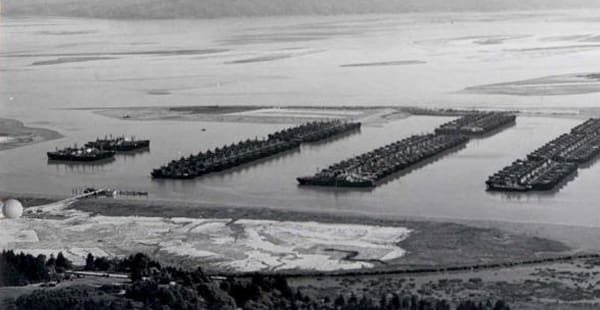Tongue Point Naval Shipyard History
Tongue Point Naval Shipyard (Tongue Point) has a long history tied to United States naval operations. Originally, Tongue Point was a small island in the Columbia River near the coastal town of Astoria, Oregon. In 1921, the U.S. Navy took control of about 395 acres when Clatsop County transferred them to the federal government. By 1924, the site was set up as a submarine and destroyer base, though it saw little use.
As World War II (WWII) approached, the Navy began converting the site into Tongue Point Naval Air Station (NAS) for seaplanes. Between 1939 and 1941, land south of the island was built up using dredged sediment. This work turned Tongue Point into a peninsula and expanded it to about 840 acres. Most of this new area was paved to support runways and buildings.
From 1941 to 1946, Tongue Point operated as a seaplane base. It had hangars, fueling systems, maintenance shops and ramps that allowed PBY Catalina seaplanes to reach the river. The Navy also built living quarters, medical facilities, recreation areas, a sewage plant and burn pits. Many of these buildings, as well as the planes and ships on-site, may have contained asbestos materials.
After seaplane operations ended in 1946, the site became part of the Pacific Reserve Fleet. The river was dredged again, and eight long concrete piers were added to store decommissioned ships. The reserve fleet remained until 1962 when the Navy deactivated the base and handed it to the U.S. General Services Administration (GSA).
By 1965, a Job Corps center opened on the site. Today, Tongue Point is still used for maritime work. It is home to Clatsop Community College’s MERTS program, Hyak Maritime’s shipyard and a U.S. Coast Guard facility. The area also includes a landfill from early dredging that is monitored by the U.S. Army Corps of Engineers for environmental safety.
Tongue Point Naval Shipyard History at a Glance
- Other Names: Naval Air Station Tongue Point, Tongue Point, Tongue Point Naval Air Station, Tongue Point NAS, Tongue Point Naval Base, U.S. Naval Ship Yard Tongue Point, U.S. Naval Station Tongue Point
- Location: Tongue Point, Oregon
- Owner(s): U.S. Navy
- Years of Operation: 1921 – 1962
- Wartime Operations: World War I (WWI), World War II (WWII)
- Size of Shipyards: About 840 acres
- Types of Ships Built/Serviced: Destroyers, escort aircraft carriers, lifeboats, submarines
The U.S. Navy used asbestos for many years because it was cheap, strong and could resist high temperatures. At shipyards and naval bases, asbestos was often found in boilers, pipes, pumps, insulation, gaskets, valves, electrical cables and protective coatings.
People who worked at these shipyards may face serious health problems later. This includes Navy personnel, veterans and other workers exposed to asbestos. Breathing in or swallowing tiny asbestos fibers can cause diseases like mesothelioma and lung cancer.
Resources for Mesothelioma Patients
Asbestos at Tongue Point Naval Shipyard
During the 1900s, asbestos was heavily used in shipbuilding at U.S. shipyards. By 1939, it was considered a critical material. Companies hoping to secure military contracts were required to use asbestos when building vessels.
As a result, shipyards like Tongue Point used large amounts of asbestos, especially during WWII. The mineral was in many products, so building, maintaining and repairing ships all carried risks. Equipment across the shipyard also contained asbestos.
Workers could be exposed to asbestos not just on ships but throughout the shipyard. They moved asbestos materials between storage areas and ships. Pallets, crates and packaging often carried loose fibers. Even routine tasks, like opening containers, could release those fibers into the air.
Asbestos Exposure at Tongue Point Naval Shipyard
Many workers at Tongue Point Naval Shipyard may have faced daily exposure to asbestos. Often, these workers cut, sanded or removed asbestos products, which released harmful dust and fibers into the air.
Occupations at high risk of exposure include:
- Boilermakers
- Carpenters
- Construction workers
- Crane operators
- Demolition workers
- Electricians
- Heavy equipment operators
- Insulators
- Machine operators
- Machinists
- Painters
- Pipefitters
- Sheet metal workers
- Shipyard workers
- Veterans
- Welders
Those working in tight spaces on ships, like engine or boiler rooms, had an even higher risk. Poor ventilation in these areas allowed asbestos fibers to build up. People who didn’t work with asbestos directly could still breathe in fibers spread around the shipyard.
Family members also faced risks from secondary exposure. Workers could carry asbestos dust home on their clothing or hair, unintentionally exposing others in the household.
Asbestos is still found in many old ships and buildings. If the material is disturbed during repairs or demolition, workers could still risk exposure to asbestos.
Asbestos Lawsuits for Tongue Point Naval Shipyard
People who develop mesothelioma as a result of exposure at Tongue Point Naval Shipyard have legal options to seek compensation. Some shipyard workers and Navy veterans who later developed asbestos diseases have filed claims or lawsuits. These cases may be against the shipyards or the companies that made or supplied asbestos materials.
Workers from Tongue Point diagnosed with a related illness may be eligible to take legal action. Talking with an asbestos lawyer can help them learn about their rights and possible compensation.
Asbestos Trusts Associated With Tongue Point Naval Shipyard
Tongue Point Naval Shipyard does not have an asbestos trust fund. But workers may be able to file claims against the companies that supplied asbestos products to the shipyard.
Asbestos Trust Funds and Eligible Years of Employment
The following company provided asbestos products to Tongue Point Naval Shipyard. It later faced many lawsuits for exposing people to asbestos and filed for bankruptcy. This company set up a trust fund to pay those harmed. Someone who worked at Tongue Point and developed a disease like mesothelioma may be eligible to file a claim against the trust.
| Asbestos Company Name | Eligibility Start Date | Eligibility End Date |
|---|---|---|
| Babcock & Wilcox | 1/1/1940 | 12/31/1982 |









